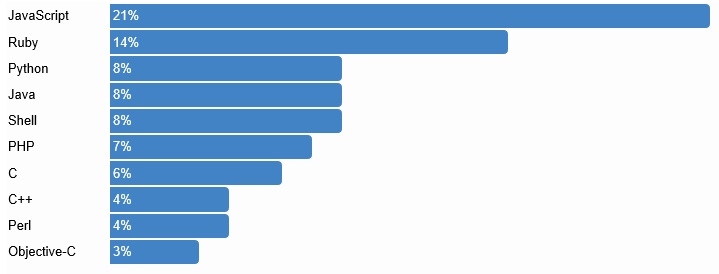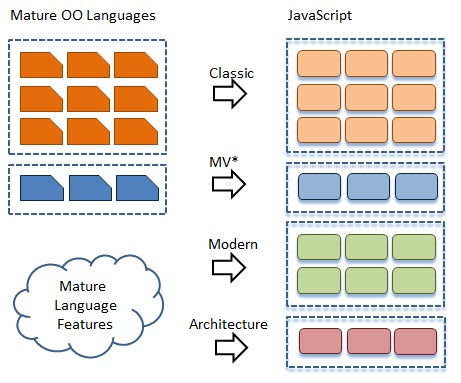Exploring the role of Design Pattern in JavaScript.
JavaScript Patterns are pragmatic design solutions to common software challenges. Some of the Modern JavaScript Patterns attempt to implement features that are missing from the JavaScript language.
JavaScript has been around since the mid 90's. For most of this time, its use was limited to simple, non-critical tasks such as changing DOM elements or make letters dance on a web page. This changed dramatically with the introduction of Web 2.0 and AJAX, just a few years ago. Since then the interest and use of JavaScript has exploded. You can see this clearly on github.com where JavaScript is listed as the most popular language.

Of course, the github figures are mostly about open source projects and in the commercial world the numbers are different. You can check tiobe.com for the most popular programming languages as determined by references on the web in the form of jobs, training courses, blogs, etc. They have JavaScript ranked as #11. Actually, this may be an underrepresentation because almost all internet developers are dealing with JavaScript one way or another. Programming positions or skills are usually listed by backend programming skills (Rails, PHP, .NET, Java) rather than JavaScript which, together with HTML and CSS, is frequently considered a 'supplementary' skill.
The bottom line is that JavaScript's popularity has increased dramatically in recent years and with it an interest in techniques for building well-structured, large-scale applications using design patterns and pattern architectures.
If you are programming in JavaScript or jQuery you are already using patterns, possibly without realizing it. For example, if you are writing event handlers you're using the Observer pattern; if you are looping over a collection of data items you are using the Iterator pattern, and if you are using jQuery like this $("#div").addClass("focus").css("border","3px"); you are using the Chaining pattern. Design patterns are deeply embedded in the world of JavaScript programming. We will look at all these examples and more in greater detail at the appropriate sections.
The traditional GoF patterns (discussed in our Classic pattern section) involve advanced object-oriented designs with an emphasis on object composition and object relationships. Many of the 23 patterns are relevant to JavaScript, but others less so. JavaScript is a flexible language with the unique ability to change object definitions at runtime rendering some of the original GoF patterns irrelevant.
How do Patterns evolve?
As you know, our website (www.dofactory.com) focuses on design patterns.
A few times we have been contacted by developers who tell us about a solution they developed for a particular problem and they are wondering whether
it qualifies as a pattern or not; and if so, how does one take it to the next level and make it into an 'official' design pattern.
We tell them to fill out a form, attach a $195 application fee, put it in an envelope, and mail it to the Pattern Regulatory Agency. Okay, okay, just kidding… There is no such thing as a committee that approves or rejects pattern applications. Design Patterns evolve naturally. Let's look at a hypothetical scenario in the area of network programming.
Typically, it starts with a blogger or open-source contributor who writes about a solution they developed for a particular software design problem. Others pick up on the idea, test it, modify it, refine it, and publish their enhancements. Then, a developer realizes there are strong similarities with the Proxy pattern (which has been known for many years) and people start referring to this solution as the Net Proxy pattern (because it solves a particular networking problem). It is a useful solution and more and more developers start picking up on the idea. And this is how this pattern starts its life in the network programming field.
What this shows is that the evolution of new patterns is a natural process and that the crowd determines which ones are worthwhile and which ones not. Furthermore, there is no formality in documenting patterns and there is no oversight to ensure that these solutions meet the pattern criteria as described by GoF. In the process, the concept of a design pattern has been loosened (or diluted, depending on your perspective) to a more pragmatic, ready-to-use solution that helps solve a common problem in software development.
A good example of this pragmatism is how JavaScript library developers interpret the Model View patterns which include MVC, MVP, and MVVM (we have an entire section on MV* patterns). The MV* patterns have been around for many years, are well understood, and are very clearly defined. JavaScript developers have embraced these patterns with the release of numerous JavaScript MV* libraries and frameworks including Backbone, Knockout, Ember, and Angular.
However, what is different is that most of these cannot be easily categorized as MVC, MVP or MVVM. They all have some flavor of a Model and a View but their responsibilities and interactions are frequently quite different from the original patterns. This has led to the MVA moniker: Model View Anything. Again, this is another example of JavaScript developers building pragmatic pattern solutions that work for them but with little or no formality.
There is yet another force at play. Many JavaScript programmers have a background in developing apps using mature object-oriented programming environments, such as, Java, C++, C#, Ruby, and PHP. When they started doing more and more in JavaScript, it became clear very quickly that the language is lacking many features that are common in other languages, such as namespaces, packages, access level modifiers: private, public, protected, and more.
JavaScript is a small (but flexible) language that was never designed for large-scale applications development. Several of the more recent patterns (discussed in the Modern and Architecture patterns sections) implement modern language features that are missing from JavaScript and that allow structured, large-scale application development. Examples of these patterns include Module, Namespace, Overload and AMD.
The diagram below depicts how JavaScript has adopted and extended the design patterns coming from the mature OO development world. The patterns on the left (mature OO languages) are highly structured and well defined whereas the ones on the right (JavaScript) are far more loosely defined and do not necessarily adhere to the narrow definitions that exists on the left.

Four categories of patterns can be identified in JavaScript: Classic, MV*, Modern, and Architecture. They are all listed in the above figure. The Classic patterns are the 23 GoF patterns. MV* refers to the Model View Patterns. Both the Classic and MV* patterns have been adjusted to optimally work within JavaScript. Each of these categories is discussed in their own section.
Many of the patterns in the Modern and Architecture patterns categories are specific to JavaScript. The difference between Modern and Architecture patterns is the level at which they operate. Modern and Architecture patterns are each discussed in their own section.